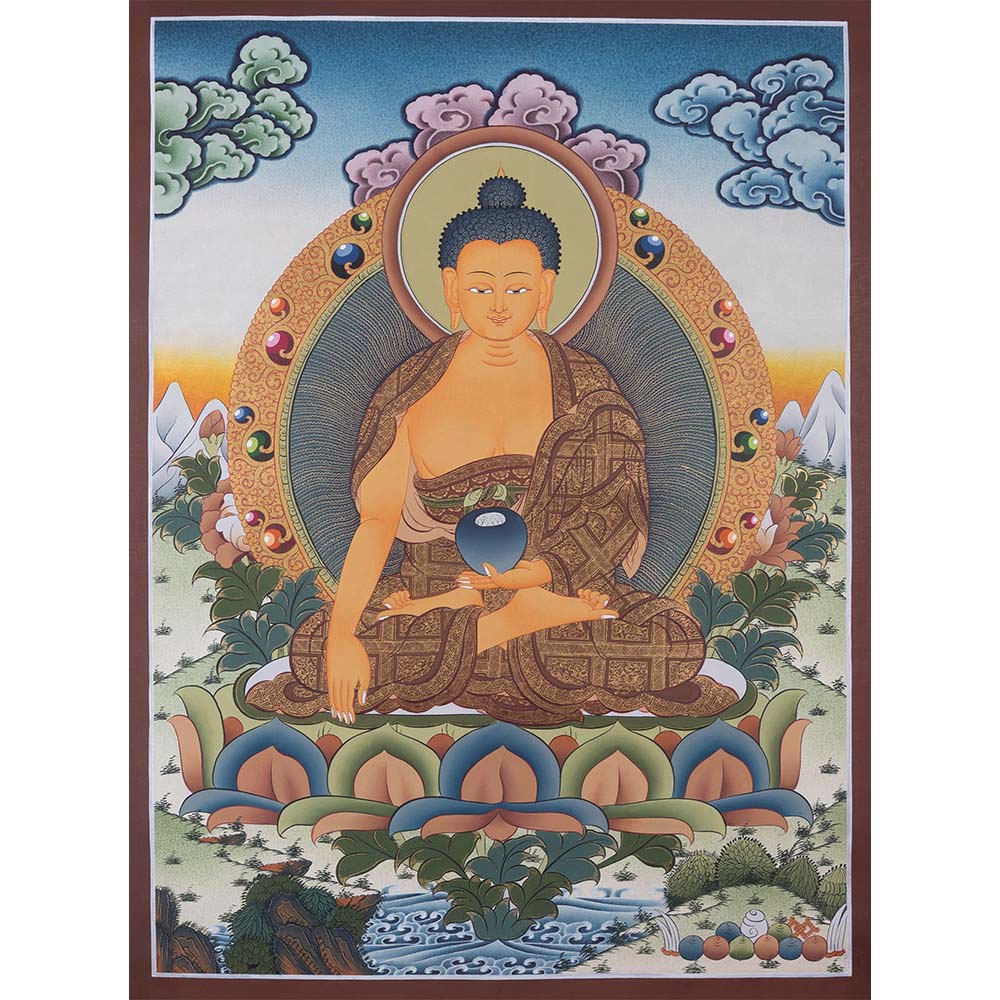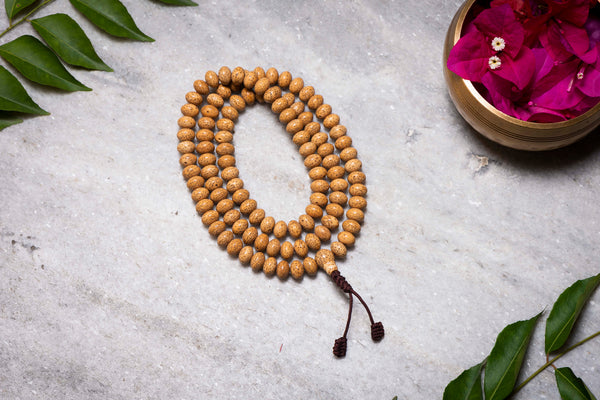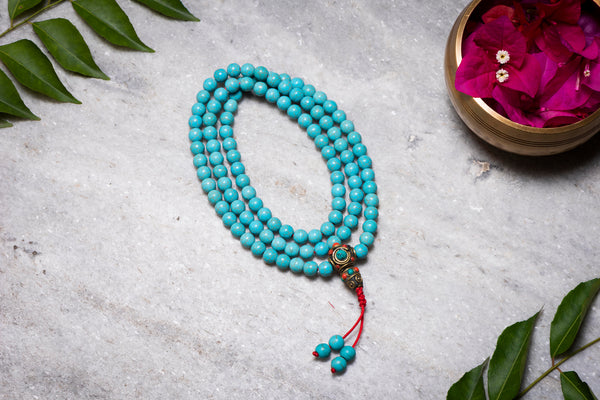Shakyamuni Buddha Thangkas: Significance, Symbolism and Divine Landscapes
Posted by ABISHEK SHRESTHA

Thangka paintings of Shakyamuni Buddha (the historical Buddha) are not only visually captivating, but also rich in symbolism and spiritual significance. These Tibetan Buddhist scroll paintings often depict Shakyamuni Buddha in serene meditation, surrounded by iconographic details that tell a deeper story. For a collector or a spiritually curious buyer, understanding the meaning behind a Shakyamuni Buddha thangka can greatly enrich the experience of owning one. Below, we explore the Buddha’s significance in Thangka art, how such thangkas are used in practice, and the hidden meanings behind their visual elements.
Who is Shakyamuni Buddha?
 Shakyamuni Buddha (Siddhartha Gautama) is the historical founder of Buddhism, revered as the enlightened teacher whose insights form the foundation of the Dharma. In Tibetan Thangka art, he is often honored as the “Supreme Buddha” of our age – not a god, but a human being who achieved enlightenment through his own effort. His life exemplifies overcoming the causes of suffering (craving, hatred, and delusion) and attaining true peace. Because of this, Shakyamuni stands as a universal model, guide, and inspiration for Buddhists; his image in art reminds devotees that enlightenment is attainable by ordinary people. In fact, all Buddhist schools highly venerate Shakyamuni as the “founding father” of the tradition, which is why he remains one of the most frequently depicted figures in Thangka paintings. Interested in learning more about Shakyamuni Buddha? Click here for details.
Shakyamuni Buddha (Siddhartha Gautama) is the historical founder of Buddhism, revered as the enlightened teacher whose insights form the foundation of the Dharma. In Tibetan Thangka art, he is often honored as the “Supreme Buddha” of our age – not a god, but a human being who achieved enlightenment through his own effort. His life exemplifies overcoming the causes of suffering (craving, hatred, and delusion) and attaining true peace. Because of this, Shakyamuni stands as a universal model, guide, and inspiration for Buddhists; his image in art reminds devotees that enlightenment is attainable by ordinary people. In fact, all Buddhist schools highly venerate Shakyamuni as the “founding father” of the tradition, which is why he remains one of the most frequently depicted figures in Thangka paintings. Interested in learning more about Shakyamuni Buddha? Click here for details.
The Significance of Shakyamuni Buddha in Thangka Art
 In the broader Tibetan Thangka tradition, Shakyamuni Buddha often occupies a central place, both literally and figuratively. Many lineage thangkas and teaching depictions position Shakyamuni at the center or top, signifying that all Buddhist teachings trace back to him. For example, an 18th-century Gelug-pa thangka shows Shakyamuni seated on a lotus in monk’s robes, flanked by his two chief disciples (Shariputra and Maudgalyayana), with the revered teacher Tsongkhapa depicted above him. Entire Thangka compositions are also dedicated to the Life of the Buddha, illustrating key episodes from Shakyamuni’s birth to enlightenment and beyond. No matter the scene, the Buddha is typically portrayed with certain identifying traits – the serene expression, monastic robes, and sacred hand gestures – that have been faithfully repeated in countless thangkas over the centuries. This continuity underlines his enduring importance: each representation of Shakyamuni in art serves as a visual scripture, conveying his teachings and example to those who view it.
In the broader Tibetan Thangka tradition, Shakyamuni Buddha often occupies a central place, both literally and figuratively. Many lineage thangkas and teaching depictions position Shakyamuni at the center or top, signifying that all Buddhist teachings trace back to him. For example, an 18th-century Gelug-pa thangka shows Shakyamuni seated on a lotus in monk’s robes, flanked by his two chief disciples (Shariputra and Maudgalyayana), with the revered teacher Tsongkhapa depicted above him. Entire Thangka compositions are also dedicated to the Life of the Buddha, illustrating key episodes from Shakyamuni’s birth to enlightenment and beyond. No matter the scene, the Buddha is typically portrayed with certain identifying traits – the serene expression, monastic robes, and sacred hand gestures – that have been faithfully repeated in countless thangkas over the centuries. This continuity underlines his enduring importance: each representation of Shakyamuni in art serves as a visual scripture, conveying his teachings and example to those who view it.
Symbolism and Hidden Meanings in Shakyamuni Buddha Thangkas
Every detail in a Shakyamuni Buddha thangka carries symbolic meaning, woven from the rich tapestry of Tibetan Buddhist iconography. Artists follow strict guidelines for proportions and symbols so that each gesture, color, and ornament conveys a specific aspect of the enlightened mind. Below are some key visual elements of a typical Shakyamuni Buddha thangka and their hidden meanings:
1. Seated Posture (Vajra Pose)
Shakyamuni Buddha is shown in full lotus position (vajrasana), the posture in which he attained enlightenment under the Bodhi Tree. It symbolizes unwavering calm, deep meditation, and spiritual stability.
2. Earth-Touching Mudra (Bhumisparsha) Shakyamuni’s right hand often stretches down over his knee with fingers touching the ground. This gesture, known as the bhumisparsha mudra (Sanskrit for “touching the earth”), represents the pivotal moment of his enlightenment. According to legend, when Mara (the lord of delusion) challenged the Buddha’s right to awaken, Shakyamuni touched the earth to witness his countless past virtues. The earth goddess answered his call, and Mara was vanquished. Thus, the earth-touching mudra symbolizes the Buddha’s victory over temptation and ignorance, as well as his firm resolve to seek truth. It is a visual reminder of the exact instant Gautama became the Buddha, grounded in unshakeable truth.
Shakyamuni’s right hand often stretches down over his knee with fingers touching the ground. This gesture, known as the bhumisparsha mudra (Sanskrit for “touching the earth”), represents the pivotal moment of his enlightenment. According to legend, when Mara (the lord of delusion) challenged the Buddha’s right to awaken, Shakyamuni touched the earth to witness his countless past virtues. The earth goddess answered his call, and Mara was vanquished. Thus, the earth-touching mudra symbolizes the Buddha’s victory over temptation and ignorance, as well as his firm resolve to seek truth. It is a visual reminder of the exact instant Gautama became the Buddha, grounded in unshakeable truth.
3. Meditation Mudra and Alms Bowl
Shakyamuni’s left hand rests in his lap in the dhyana mudra (meditation gesture), often holding a black or blue alms bowl. This symbolizes his deep concentration, renunciation of luxury, and reliance on generosity. The bowl may contain nectar or herbs, representing the nourishing power of the Dharma.
4. Monk’s Robes
He wears simple, patchwork monastic robes draped over one shoulder. These robes signify humility, detachment from worldly wealth, and his life as a renounced teacher.
5. Lotus Throne and Aura
Seated on a blooming lotus, he symbolizes purity rising above worldly suffering. A radiant aura behind him represents his enlightened energy and the illumination of wisdom. In some thangkas, a sun and moon disk rest atop the lotus seat just beneath the Buddha: the sun represents prajñā (transcendent wisdom) and the moon represents upāya (skillful compassion in action). Together, these indicate that Shakyamuni’s enlightenment perfectly united wisdom and compassion.
6. Lion Throne Base
Lions beneath his seat signify his royal heritage and his role as the “Dharma King.” The lion also represents the fearless power of his teachings—often called the “Lion’s Roar.”
7. Attendant Figures (Disciples/Bodhisattvas)
Classic thangkas often flank the Buddha with his two chief disciples: Shariputra (wisdom) and Maudgalyayana (miraculous powers), symbolizing the teacher-student lineage. In Mahayana traditions, bodhisattvas like Avalokiteshvara (compassion) and Manjushri (wisdom) may appear, reinforcing the Buddha’s role as the source of Dharma. Their presence highlights the continuity of enlightenment teachings for the benefit of all beings.
8. Physical Characteristics of Buddhahood
In Shakyamuni Buddha thangkas, key symbolic features convey profound meaning: the ushnisha (cranial protuberance) represents supreme wisdom, while elongated earlobes recall his princely past and now signify renunciation of wealth and compassionate attunement to suffering beings; subtle marks like the urna (forehead dot) and neck lines further identify him as an enlightened being, transforming the image into a visual embodiment of Buddhist ideals.
Divine Landscapes: The Spiritual Language of Thangka Backgrounds
1. Seated Posture (Vajra Pose)
Shakyamuni Buddha is shown in full lotus position (vajrasana), the posture in which he attained enlightenment under the Bodhi Tree. It symbolizes unwavering calm, deep meditation, and spiritual stability.
2. Rivers, Lakes & Waterfalls
These symbolize the flow of samsara and the purification of karma. Flowing water also reflects the dynamic energy that carries practitioners toward enlightenment.
3. Sky, Clouds & Rainbow Arches
Soft clouds or rainbow arcs above the Buddha evoke sacred atmosphere, divine energy, and the celestial realm—connecting earthly practice with transcendent reality.
4. Flowers & Trees
Beyond the lotus throne, other flora-like Bodhi trees or sacred groves - are painted to signify places of key moments in the Buddha’s spiritual journey and the enlightenment context.
5. Ashtamangala & Auspicious Motifs
Elements like conch shells, endless knots, parasols, golden fishes, and victory banners may be delicately incorporated into the scene. These symbols represent the Buddha’s eternal teachings, unity of wisdom and compassion, protection, abundance, and victory over ignorance.
6. Snow Lions & Mythic Animals
Snow lions often support the Buddha’s pedestal, symbolizing joy, fearlessness, and protector roles. They represent the Dharma’s power and reflect Tibet’s highland spirit.
Bring peace, wisdom, and sacred beauty into your space - Shop our authentic Shakyamuni Buddha Thangka painting today.









